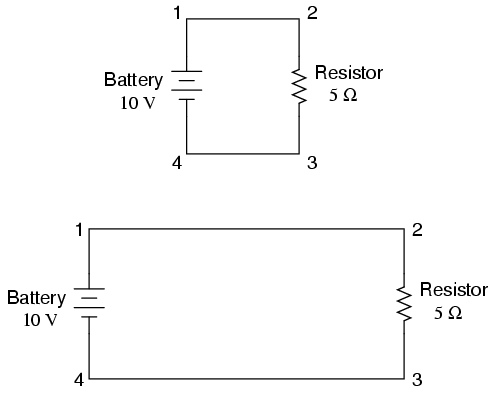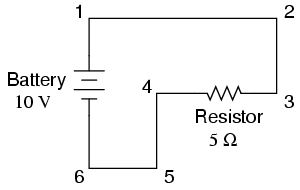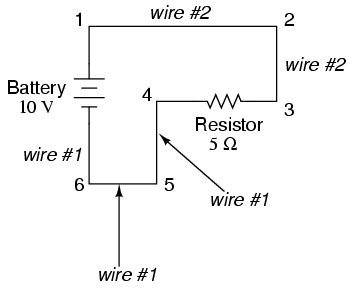Circuit wiring
So far, we've been analyzing single-battery,
single-resistor circuits with no regard for the connecting
wires between the components, so long as a complete circuit
is formed. Does the wire length or circuit "shape" matter to
our calculations? Let's look at a couple of circuit
configurations and find out:

When we draw wires connecting points in a
circuit, we usually assume those wires have negligible
resistance. As such, they contribute no appreciable effect
to the overall resistance of the circuit, and so the only
resistance we have to contend with is the resistance in the
components. In the above circuits, the only resistance comes
from the 5 Ω resistors, so that is all we will consider in
our calculations. In real life, metal wires actually do
have resistance (and so do power sources!), but those
resistances are generally so much smaller than the
resistance present in the other circuit components that they
can be safely ignored. Exceptions to this rule exist in
power system wiring, where even very small amounts of
conductor resistance can create significant voltage drops
given normal (high) levels of current.
If connecting wire resistance is very little
or none, we can regard the connected points in a circuit as
being electrically common. That is, points 1 and 2 in
the above circuits may be physically joined close together
or far apart, and it doesn't matter for any voltage or
resistance measurements relative to those points. The same
goes for points 3 and 4. It is as if the ends of the
resistor were attached directly across the terminals of the
battery, so far as our Ohm's Law calculations and voltage
measurements are concerned. This is useful to know, because
it means you can re-draw a circuit diagram or re-wire a
circuit, shortening or lengthening the wires as desired
without appreciably impacting the circuit's function. All
that matters is that the components attach to each other in
the same sequence.
It also means that voltage measurements
between sets of "electrically common" points will be the
same. That is, the voltage between points 1 and 4 (directly
across the battery) will be the same as the voltage between
points 2 and 3 (directly across the resistor). Take a close
look at the following circuit, and try to determine which
points are common to each other:

Here, we only have 2 components excluding
the wires: the battery and the resistor. Though the
connecting wires take a convoluted path in forming a
complete circuit, there are several electrically common
points in the electrons' path. Points 1, 2, and 3 are all
common to each other, because they're directly connected
together by wire. The same goes for points 4, 5, and 6.
The voltage between points 1 and 6 is 10
volts, coming straight from the battery. However, since
points 5 and 4 are common to 6, and points 2 and 3 common to
1, that same 10 volts also exists between these other pairs
of points:
Between points 1 and 4 = 10 volts
Between points 2 and 4 = 10 volts
Between points 3 and 4 = 10 volts (directly across the resistor)
Between points 1 and 5 = 10 volts
Between points 2 and 5 = 10 volts
Between points 3 and 5 = 10 volts
Between points 1 and 6 = 10 volts (directly across the battery)
Between points 2 and 6 = 10 volts
Between points 3 and 6 = 10 volts
Since electrically common points are
connected together by (zero resistance) wire, there is no
significant voltage drop between them regardless of the
amount of current conducted from one to the next through
that connecting wire. Thus, if we were to read voltages
between common points, we should show (practically) zero:
Between points 1 and 2 = 0 volts Points 1, 2, and 3 are
Between points 2 and 3 = 0 volts electrically common
Between points 1 and 3 = 0 volts
Between points 4 and 5 = 0 volts Points 4, 5, and 6 are
Between points 5 and 6 = 0 volts electrically common
Between points 4 and 6 = 0 volts
This makes sense mathematically, too. With a
10 volt battery and a 5 Ω resistor, the circuit current will
be 2 amps. With wire resistance being zero, the voltage drop
across any continuous stretch of wire can be determined
through Ohm's Law as such:

It should be obvious that the calculated
voltage drop across any uninterrupted length of wire in a
circuit where wire is assumed to have zero resistance will
always be zero, no matter what the magnitude of current,
since zero multiplied by anything equals zero.
Because common points in a circuit will
exhibit the same relative voltage and resistance
measurements, wires connecting common points are often
labeled with the same designation. This is not to say that
the terminal connection points are labeled the same,
just the connecting wires. Take this circuit as an example:

Points 1, 2, and 3 are all common to each
other, so the wire connecting point 1 to 2 is labeled the
same (wire 2) as the wire connecting point 2 to 3 (wire 2).
In a real circuit, the wire stretching from point 1 to 2 may
not even be the same color or size as the wire connecting
point 2 to 3, but they should bear the exact same label. The
same goes for the wires connecting points 6, 5, and 4.
Knowing that electrically common points have
zero voltage drop between them is a valuable troubleshooting
principle. If I measure for voltage between points in a
circuit that are supposed to be common to each other, I
should read zero. If, however, I read substantial voltage
between those two points, then I know with certainty that
they cannot be directly connected together. If those points
are supposed to be electrically common but they
register otherwise, then I know that there is an "open
failure" between those points.
One final note: for most practical purposes,
wire conductors can be assumed to possess zero resistance
from end to end. In reality, however, there will always be
some small amount of resistance encountered along the length
of a wire, unless it's a superconducting wire. Knowing this,
we need to bear in mind that the principles learned here
about electrically common points are all valid to a large
degree, but not to an absolute degree. That is, the
rule that electrically common points are guaranteed to have
zero voltage between them is more accurately stated as such:
electrically common points will have very little
voltage dropped between them. That small, virtually
unavoidable trace of resistance found in any piece of
connecting wire is bound to create a small voltage across
the length of it as current is conducted through. So long as
you understand that these rules are based upon ideal
conditions, you won't be perplexed when you come across some
condition appearing to be an exception to the rule.
-
REVIEW:
-
Connecting wires in a circuit are assumed
to have zero resistance unless otherwise stated.
-
Wires in a circuit can be shortened or
lengthened without impacting the circuit's function -- all
that matters is that the components are attached to one
another in the same sequence.
-
Points directly connected together in a
circuit by zero resistance (wire) are considered to be
electrically common.
-
Electrically common points, with zero
resistance between them, will have zero voltage dropped
between them, regardless of the magnitude of current
(ideally).
-
The voltage or resistance readings
referenced between sets of electrically common points will
be the same.
-
These rules apply to ideal
conditions, where connecting wires are assumed to possess
absolutely zero resistance. In real life this will
probably not be the case, but wire resistances should be
low enough so that the general principles stated here
still hold
|